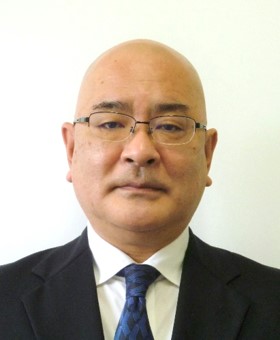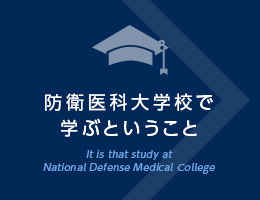センター長挨拶

防衛医学研究は、わが国の防衛はもちろんのことテロ、大規模災害、感染症危機管理事態などの様々な事態への対応を任務とする隊員の①安全の確保、②壮健性の維持、③持続性・強靭化の確保、④任務遂行能力の向上を図るため、防衛医科大学校の総力をあげて行う基礎医学・臨床医学を基盤とする応用医学研究です。私どもの防衛医学研究センターは、これらの研究を中心的に、迅速かつ強力に推し進めるための組織です。
防衛医学研究センターは、阪神淡路大震災や地下鉄サリン事件が起こった1995年の翌年(1996年)に、「大規模災害等における集団を対象とした救命・救急医学の総合的な研究を行う」ことを目的に設置されました。当初は、「外傷研究部門」、「医療工学研究部門」、「異常環境衛生研究部門」の3部門でスタートしましたが、1997年には「行動科学研究部門」、「情報システム研究部門」が追加された5部門体制となりました。2012年には、国内外での新興・再興感染症の脅威から隊員を守るために「感染症疫学対策研究官」が追加設置されました。2016年には、組織改編によって「外傷研究部門」、「医療工学研究部門」、「特殊環境衛生研究部門」、「行動科学研究部門」、「生体情報・治療システム研究部門」、「広域感染症疫学・制御研究部門」の6部門体制となり、2024年には隊員のバイオバンクを構築しビッグデータによる高度な研究・教育を支援する「バイオ情報管理室」、米国軍等と緊密に連携し国際共同研究を推し進める「国際交流研究官:International Research Collaboration Officer」を新設するなど研究基盤の整備を図っています。
防衛医学研究センターのミッションは、以下の4本柱としています。
- 自衛隊医療の高度化のために、部内各機関、他大学・他府省庁研究機関・企業などとの連携によって、高度な学術的価値を有する防衛医学研究を推進し、その成果を積極的に発信する
- 激変する防衛・軍事医学の世界動向に関する最新情報を収集・分析し、自衛隊衛生における政策・研究戦略の立案に貢献する(シンクタンク的機能)
- 米軍、NATO軍、ASEAN軍等に対する研究面での支援・連携強化などを通じて、国際安全保障の貢献を図る
- 学生・医官等の研究能力向上を図るため、研究指導者の教育・人材育成並びに研究環境の整備を行う
昨今の防衛・軍事医学の動向の大きな変化をうけて、我々が推し進めるべき防衛医学研究の方向性も、従来の戦傷病、CBRNE攻撃対処、救命用輸血体制に関わる研究、特殊環境下での健康管理、メンタルヘルス、大規模自然災害対処、感染症の脅威分析・実地疫学調査対応などに加えて、急速に進歩・変容する軍事技術(電子戦、指向性エネルギー兵器、AI兵器・認知戦など)へ対応するために、物理エネルギー生体影響研究や脳・認知科学研究に取り組む必要性が出てきています。
我々の研究成果については、自衛隊はもとより、安全保障の関係者、さらに広く一般の方々に共有・活用していただくために、さまざまな機会をとらえて広報、公表いたします。皆様のご理解とご協力を賜りますれば幸甚です。
防衛医学研究センター長 加來浩器
Greetings from the Director of the National Defense Medical College Research Institute
(NDMCRI)
Defense medical research is applied medical research based on basic and clinical medicine conducted by the National Defense Medical College (NDMC) to ensure the safety, maintain the health, and enhance the strength and capability of the personnel who respond to various missions such as terrorism, large-scale disaster response, and infectious disease crisis management, as well as to defend Japan under the recent increasingly tense international security environment. Our NDMCRI is a centralized, rapid, and powerful organization to promote these studies.
NDMCRI was established in 1996, the year after the Great Hanshin-Awaji Earthquake and the Sarin gas attack on the subway in 1995, to "conduct comprehensive research on lifesaving and emergency medicine for mass casualties in large-scale disasters. Initially, there were three divisions:
the Division of Traumatology, the Division of Biomedical Engineering, the Division, and Abnormal Environmental Health Research Division.
In 1997,
the Division of Behavioral Science and the Division of Information Systems
were added to the five-division structure. In 2012, an additional position of "Infectious Disease Epidemiology Analysis Officer" was established to protect the corps members from the threat of emerging and re-emerging infectious diseases at home and abroad. In 2016, the reorganization led to the establishment of
the Division of Traumatology, the Division of Biomedical Engineering, the Divion of Environmental Medicine, the Division of Behavioral Science, the Division of Bioinformation and therapeutic system, the Division of Infectious Disease Epidemiology and Control.
In 2024,
the Bioinformation Management Office
was established to build a biobank of corps members and support advanced research and education using big data, and t
the International Exchange Research Officer
(currently recruiting) was created to promote international joint research in close cooperation with the U.S. military and other organizations.
The mission of the NDMCRI has the following four pillars
- to promote defense medical research of high academic value and to disseminate the results of such research in cooperation with the various organizations of the research department, other universities, research institutes of other ministries and agencies, and companies, in order to advance the medical care of the Self-Defense Forces.
- to collect and analyze the latest information on rapidly changing global trends in defense and military medicine, and to contribute to the formulation of policy and research strategies in the Self-Defense Forces medical field (think tank function)
- to contribute to international security by strengthening research support and collaboration with U.S., NATO, ASEAN, and other militaries
- to educate and train research leaders and improve the research environment to enhance the research capabilities of students and medical officers
In response to the recent major changes in defense and military medicine, the direction of defense medical research that we should promote should include not only conventional research on battle-related diseases, CBRNE attack response, life-saving blood transfusion system, health management under special environments, mental health, large-scale natural disaster response, threat analysis and field epidemiological studies of infectious diseases, etc., but also the rapidly advancing and changing military medical research. In addition, to respond to rapidly advancing and transforming military technologies (electronic warfare, directed energy weapons, AI weapons, cognitive warfare, etc.), it has become necessary to engage in physical energy bio-effects research and brain and cognitive science research.
We will take various opportunities to publicize and publish our research results from the viewpoint of fairness and transparency. We appreciate your understanding and cooperation.
April 1, 2024
Koki KAKU, Prof. MD, PhD







